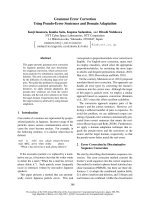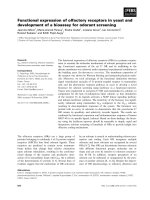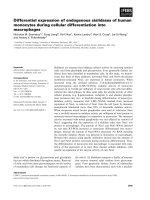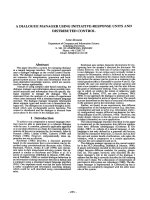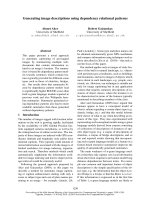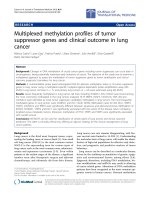Báo cáo toán học: " Facial expression recognition using local binary patterns and discriminant kernel locally linear embedding" pot
Bạn đang xem bản rút gọn của tài liệu. Xem và tải ngay bản đầy đủ của tài liệu tại đây (401.46 KB, 30 trang )
This Provisional PDF corresponds to the article as it appeared upon acceptance. Fully formatted
PDF and full text (HTML) versions will be made available soon.
Facial expression recognition using local binary patterns and discriminant
kernel locally linear embedding
EURASIP Journal on Advances in Signal Processing 2012,
2012:20 doi:10.1186/1687-6180-2012-20
Xiaoming Zhao ()
Shiqing Zhang ()
ISSN 1687-6180
Article type Research
Submission date 4 October 2011
Acceptance date 27 January 2012
Publication date 27 January 2012
Article URL />This peer-reviewed article was published immediately upon acceptance. It can be downloaded,
printed and distributed freely for any purposes (see copyright notice below).
For information about publishing your research in EURASIP Journal on Advances in Signal
Processing go to
/>For information about other SpringerOpen publications go to
EURASIP Journal on Advances
in Signal Processing
© 2012 Zhao and Zhang ; licensee Springer.
This is an open access article distributed under the terms of the Creative Commons Attribution License ( />which permits unrestricted use, distribution, and reproduction in any medium, provided the original work is properly cited.
Facial expression recognition using local binary patterns and
discriminant kernel locally linear embedding
Xiaoming Zhao
1
and Shiqing Zhang
∗2
1
Department of Computer Science, Taizhou University, Taizhou 318000, P.R. China
2
School of Physics and Electronic Engineering, Taizhou University, Taizhou 318000,
P.R. China
*
Corresponding author:
E-mail address:
XZ:
Abstract
Given the nonlinear manifold structure of facial images, a new kernel-based
supervised manifold learning algorithm based on locally linear embedding (LLE),
called discriminant kernel locally linear embedding (DKLLE), is proposed for facial
expression recognition. The proposed DKLLE aims to nonlinearly extract the
discriminant information by maximizing the interclass scatter while minimizing the
intraclass scatter in a reproducing kernel Hilbert space. DKLLE is compared with
LLE, supervised locally linear embedding (SLLE), principal component analysis
(PCA), linear discriminant analysis (LDA), kernel principal component analysis
(KPCA), and kernel linear discriminant analysis (KLDA). Experimental results on
two benchmarking facial expression databases, i.e., the JAFFE database and the
Cohn-Kanade database, demonstrate the effectiveness and promising performance of
DKLLE.
Keywords: manifold learning; locally linear embedding; facial expression
recognition.
Introduction
Affective computing, which is currently an active research area, aims at building the
machines that recognize, express, model, communicate and respond to a user’s
emotion information [1]. Within this field, recognizing human emotion from facial
images, i.e., facial expression recognition, is increasingly attracting attention and has
become an important issue, since facial expression provides the most natural and
immediate indication about a person’s emotions and intentions. Over the last decade,
the importance of automatic facial expression recognition has increased significantly
due to its applications to human-computer interaction (HCI), human emotion analysis,
interactive video, indexing and retrieval of image, etc.
An automatic facial expression recognition system generally comprises of three
crucial steps [2]: face acquisition, facial feature extraction, and facial expression
classification. Face acquisition is a preprocessing stage to detect or locate the face
regions in the input images or sequences. One of the most widely used face detector is
the real-time face detection algorithm developed by Viola and Jones [3], in which a
cascade of classifiers is employed with Harr-wavelet features. Once a face is detected
in the images, the corresponding face regions are usually normalized to have the same
eye distance and the same gray level. Facial feature extraction attempts to find the
most appropriate representation of facial images for recognition. There are mainly two
approaches: geometric features-based systems and appearance features-based systems.
In the geometric features-based systems, the shape and locations of major facial
components such as mouth, nose, eyes, and brows, are detected in the images.
Nevertheless, the geometric features-based systems require the accurate and reliable
facial feature detection, which is difficult to realize in real-time applications. In the
appearance features-based systems, the appearance changes (skin texture) of the facial
images, including wrinkles, bulges, and furrows, are presented. Image filters, such as
principal component analysis (PCA) [4], linear discriminant analysis (LDA) [5],
regularized discriminant analysis (RDA) [6] and Gabor wavelet analysis [7, 8], can be
applied to either the whole-face or specific face regions to extract the facial
appearance changes. It’s worth pointing out that it is computationally expensive to
convolve facial images with a set of Gabor filters to extract multi-scale and
multi-orientation coefficients. Moreover, in practice the dimensionality of Gabor
features is so high that the computation and memory requirements are very large. In
recent years, an effective face descriptor called local binary patterns (LBP) [9],
originally proposed for texture analysis [10], have attracted extensive interest for
facial expression representation. One of the most important properties of LBP is its
tolerance against illumination changes and its computational simplicity. So far, LBP
has been successfully applied as a local feature extraction method in facial expression
recognition [11–13]. In the last step of an automatic facial expression recognition
system, i.e., facial expression classification, a classifier is employed to identify
different expressions based on the extracted facial features. The representative
classifiers used for facial expression recognition are neural networks [14], the nearest
neighbor (1-NN) [15] or k-nearest neighbor (KNN) classifier [16], and support vector
machines (SVM) [17], etc.
In recent years, it has been proved that facial images of a person with varying
expressions can be represented as a low-dimensional nonlinear manifold embedded in
a high-dimensional image space [18–20]. Given the nonlinear manifold structure of
facial expression images, two representative manifold learning (also called nonlinear
dimensionality reduction) methods, i.e., locally linear embedding (LLE) [21] and
isometric feature mapping (Isomap) [22], have been used to project the
high-dimensional facial expression images into a low-dimensional embedded
subspace in which facial expressions can be easily distinguished from each other
[18–20, 23, 24]. However, LLE and Isomap fail to perform well on facial expression
recognition tasks due to their unsupervised ways of failing to extract the discriminant
information.
To overcome the limitations of unsupervised manifold learning methods for
supervised pattern recognition, some supervised manifold learning algorithms have
been recently proposed by means of a supervised distance measure, such as
supervised locally linear embedding (SLLE) [25] using the linear supervised distance,
probability-based LLE using a probability-based distance [26], locally linear
discriminant embedding using a vector translation and distance rescaling model [27],
and so forth. Among them, SLLE has become one of the most promising supervised
manifold learning techniques due to its simple implementation, and successfully
applied for facial expression recognition [28]. However, SLLE still has two
shortcomings. Firstly, due to the used linear supervised distance, the interclass
dissimilarity in SLLE keeps increasing in parallel while the intraclass dissimilarity is
increased. However, an ideal classification mechanism should maximize the interclass
dissimilarity while minimizing the intraclass dissimilarity. In this sense, this kind of
linear supervised distance in SLLE is not a good property for classification since it
will go to a great extent to decrease the discriminating power of the low-dimensional
embedded data representations produced with SLLE. Secondly, as a non-kernel
method, SLLE cannot explore the higher-order information of input data as SLLE
cannot employ the characteristic of a kernel-based learning, i.e., a nonlinear kernel
mapping. To tackle the above-mentioned problems of SLLE, in this article a new
kernel-based supervised manifold learning algorithm based on LLE, called
discriminant kernel locally linear embedding (DKLLE), is proposed and applied for
facial expression recognition. On one hand, with a nonlinear supervised distance
measure, DKLLE considers both the intraclass scatter information and the interclass
scatter information in a reproducing kernel Hilbert space (RKHS), and emphasizes the
discriminant information. On the other hand, with kernel techniques DKLLE extracts
the nonlinear feature information when mapping input data into some high
dimensional feature space. In order to evaluate the performance of DKLLE on facial
expression recognition, we adopt the LBP features as facial representations and then
employ DKLLE to produce the low-dimensional discriminant embedded data
representations from the extracted LBP features with striking performance
improvement on facial expression recognition tasks. The facial expression recognition
experiments are performed on two benchmarking facial expression databases, i.e., the
JAFFE database [15] and the Cohn-Kanade database [29].
The remainder of this article is organized as follows: in Section 2, LBP is introduced
briefly. In Section 3, LLE and SLLE are reviewed briefly. The proposed DKLLE
algorithm is presented in detail in Section 4. In Section 5, experiments and results are
given. Finally, the conclusions are summarized in Section 6.
Local binary patterns
The original LBP operator [10] labels the pixels of an image by thresholding a 3 × 3
neighborhood of each pixel with the center value and considering the results as a
binary code. The LBP code of the center pixel in the neighborhood is obtained by
converting the binary code into a decimal one. Figure 1 gives an illustration for the
basic LBP operator. Based on the operator, each pixel of an image is labeled with an
LBP code. The 256-bin histogram of the labels contains the density of each label and
can be used as a texture descriptor of the considered region.
The procedure of extracting LBP features for facial representations is implemented as
follows:
First, a face image is divided into several non-overlapping blocks. Second, LBP
histograms are computed for each block. Finally, the block LBP histograms are
concatenated into a single vector. As a result, the face image is represented by the
LBP code.
LLE and SLLE
LLE
Given the input data point
D
i
x R
∈ and the output data point
d
i
y R
∈
( 1,2,3, , )
i N
=
K , the standard LLE [21] consists of three steps:
Step 1: Find the number of nearest neighbors for each
i
x
based on the
Euclidean distance.
Step 2: Compute the reconstruction weights by minimizing the reconstruction
error.
Let
i
x
and
j
x
be neighbors, the reconstruction error is measured by the following
cost function:
2
1 1
( )
N N
i ij j
i j
W x W x
ε
= =
= −
∑ ∑
(1)
subject to two constraints:
∑
=
=
N
j
ij
W
1
1 and 0=
ij
W , if
i
x
and
j
x
are not
neighbors.
Step 3: Compute the low-dimensional embedding.
The low-dimensional embedding is found through the following minimization:
2
1 1
( )
N N
i ij j
i j
Y y W y
φ
= =
= −
∑ ∑
(2)
subject to two constraints:
1 1
1
0 and ,
N N
T
i i i
i i
y y y I
N
= =
= =
∑ ∑
where
I
is the dd
×
identity matrix. To find the matrix
Y
under these constraints, a new matrix
M
is
constructed based on the matrix
:
W
( ) ( ).
T
M I W I W
= − − The d eigenvectors
which correspond to the d smallest non-zero eigenvalues of
M
yield the final
embedding
Y
.
SLLE
To complement the original LLE, SLLE [25] aims to find a mapping separating
within-class structure from a between-class structure. One way to do this is to add the
distance between samples
i
x
and
j
x
in different classes to modify the first step of
the original LLE, while leaving the other two steps unchanged. This can be achieved
by artificially increasing the pre-calculated Euclidean distance (abbreviated as
∆
)
between samples belonging to different classes, but leaving them unchanged if
samples are from the same class:
]1,0[,)max(
'
∈Λ∆+∆=∆
αα
ij
(3)
where
∆
is the distance matrix without considering the class label information, and
'
∆
is the distance integrating with the class label information. If
i
x
and
j
x
belong
to the different classes, then 1=Λ
ij
and 0=Λ
ij
otherwise. In this formulation, the
constant factor
α
( 10
≤
α
≤
) controls the amount to which the class information
should be incorporated. At one extreme, when
0
α
=
, we get the unsupervised LLE.
At the other extreme, when
1
α
=
, we get the fully supervised LLE (1-SLLE). As
α
varies between 0 and 1, a partially supervised LLE (α-SLLE) is obtained. From Eq.
(3), it can be observed that when the intraclass dissimilarity (i.e.,
∆
=
∆
'
, when
0=Λ
ij
) is linearly increased, the interclass dissimilarity (i.e., )max(
'
∆+∆=∆
α
,
when 1=Λ
ij
) keeps increasing in parallel, since )max(
∆
α
is a constant. Therefore,
the used supervised distance measure in SLLE is linear.
The proposed DKLLE
A discirminant and kernel variant of LLE is developed by designing a nonlinear
supervised distance measure and minimizing the reconstruction error in a RKHS,
which gives rise to DKLLE.
Given the input data point (
,
i i
x L
), where
D
i
x R
∈ and
i
L is the class label of
i
x
,
the output data point is
d
i
y R
∈
( 1,2,3, , )
i N
=
K . The detailed steps of DKLLE are
presented as follows:
Step 1: Perform the kernel mapping for each data point
i
x
.
A nonlinear mapping
ϕ
is defined as:
: , ( )
D
R x x
ϕ ϕ
→ a
F
The input data point
i
x
is mapped with the nonlinear mapping
ϕ
, into some
potentially high-dimensional feature space
F
. Then, an inner product
,
〈 〉
can be
defined on
F
for a chosen
ϕ
, which makes a so-called RHKS. In a RHKS, a
kernel function
( , )
i j
x x
κ
can be defined as:
( , ) ( ), ( ) ( ) ( )
T
i j i j i j
x x x x x x
κ ϕ ϕ ϕ ϕ
= 〈 〉 = (4)
where
κ
is called a kernel.
Step 2: Find the nearest neighbors for each
( )
i
x
ϕ
by using a nonlinear
supervised kernel distance.
The kernel Euclidean distance measure [30] for two data points
i
x
and
j
x
induced by a kernel
κ
can be defined as:
( , ) ( ) ( ), ( ) ( ) ( , ) 2 ( , ) ( , )
i j i j i j i i i j j j
Dist x x x x x x x x x x x x
ϕ ϕ ϕ ϕ κ κ κ
= 〈 − − 〉 = − + (5)
Let
Dist
denotes the kernel distance matrix for all the input data points, i.e.,
( , ), , 1, 2, ,
i j
Dist Dist x x i j N
= = K . To preserve the intraclass neighboring geometry,
while maximizing the interclass scatter, a nonlinear supervised kernel distance
measure
KDist
in a RHKS can be defined as:
2
2
1
Dist
i j
Dist
i j
e L L
KDist
e L L
β
β
α
−
− =
=
− ≠
(6)
where
KDist
is the supervised kernel distance matrix with the class label
information, while
Dist
is the kernel Euclidean distance matrix without the class
label information.
α
is a constant factor ( 10
≤
α
≤
) and gives a certain chance for
the data points in different classes to be more similar so that the dissimilarity in
different classes may be smaller than that in the same class.
β
is used to prevent the
supervised kernel distance matrix
KDist
from increasing too fast when the kernel
Euclidean distance matrix
Dist
is relatively large, since
Dist
is in the exponent.
Hence, the value of
β
should depend on the “density” of data sets and it is usually
feasible to set
β
to be the average kernel Euclidean distance between all pairs of
data points.
As shown in Eq. (6), we can make two observations. First, both the interclass
dissimilarity and the intraclass dissimilarity in
KDist
, is monotone increasing with
respect to the kernel Euclidean distance. This ensures that the main geometric
structure of the original data sets can be preserved well in the process of
dimensionality reduction. Second, the interclass dissimilarity in
KDist
can be
always definitely larger than the intraclass dissimilarity, conferring a high
discriminating power of DKLLE’s low-dimensional embedded data representations.
This is a good property for classification.
Step 3: Measure the reconstruction error in a RHKS.
The reconstruction error is measured by the following cost function:
2
,
1 1
( ) ( ) ( )
N k
i ij j i
i j
W x W x
ε ϕ ϕ
= =
= −
∑ ∑
(7)
where
k
is the number of nearest neighbors. Given the constraint:
∑
=
=
N
j
ij
W
1
1, the
reconstruction error can be rewritten as follows:
2 2
, ,
1 1 1 1 1
( ) ( ) ( ) ( ( ) ( )) ( )
N k N k N
i ij j i ij i j i i
i j i j i
W x W x W x x W
ε ϕ ϕ ϕ ϕ ε
= = = = =
= − = − =
∑ ∑ ∑ ∑ ∑
(8)
Let
1, 2, ,
[ ( ) ( ), ( ) ( ), , ( ) ( )]
i i i i i i k i
P x x x x x x
ϕ ϕ ϕ ϕ ϕ ϕ
= − − −K , then
2
2
,
1
( ) ( ( ) ( ))
k
T T T
i ij i j i i i i i i
j
W W x x PW W P PW W KW
ε ϕ ϕ
=
= − = = =
∑
(9)
where
T
K P P
=
is a positive semi-definite kernel matrix. To compute the optimal
weight
i
W
, the following Lagrange function is formulated with the constraint
1
T
i
W
=
1
.
( (1,1, ,1) )
T
=1 K
1
1
( , ) ( 1)
T T
i i i i
i
T
L W W KW W
K
W
K
λ λ
−
−
= − −
⇒ =
1
1
1 1
(10)
Performing eigen-decomposition, let
T
K U U
= Λ
, then
1
1
T
i
T T
U U
W
U U
−
−
Λ
=
Λ
1
1 1
(11)
Therefore, the reconstruction weights can be computed by the kernel matrix’s
eigenvalues and eigenvectors.
Step 4: Compute the final embedding.
As LLE done, the following embedding cost function is minimized.
2
1 1
( ) ( )
N N
T
i ij j
i j
Y y W y tr Y MY
φ
= =
= − =
∑ ∑
(12)
where
( ) ( )
T
M I W I W
= − − , subject to two constraints:
1 1
1
0 and
N N
T
i i i
i i
y y y I
N
= =
= =
∑ ∑
. The final embedding
Y
comprises d
eigenvectors corresponding to d smallest non-zero eigenvalues of
.
M
Experiments and results
To verify the effectiveness of the proposed DKLLE, we use two benchmarking facial
expression databases, i.e., the JAFFE database [15] and the Cohn-Kanade Database
[29], for facial expression recognition experiments. Each database contains seven
emotions: anger, joy, sad, neutral, surprise, disgust, and fear. The performance of
DKLLE is compared with LLE, SLLE, PCA, LDA, kernel principal component
analysis (KPCA) [31], and kernel linear discriminant analysis (KLDA) [32]. The
typical Gaussian kernel
(
)
2
2
( , ) exp 2
i j i j
x x x x
κ σ
= − − is used for KPCA, KLDA,
and DKLLE, and the parameter
σ
is empirically set to 1 for its satisfying
performance. The number of nearest neighbors for LLE, SLLE, and DKLLE is fixed
with an adaptive neighbor selection technique [33]. To cope with the embeddings of
the new samples, the out-of-sample extensions of LLE and SLLE are developed by an
existed linear generalization technique [34], in which a linear relation is built between
the high and low-dimensional spaces and then the adaptation to a new sample can be
done by updating the weight matrix
W
. As a kernel method, the proposed DKLLE
can directly project the new samples into a low-dimensional space by using a kernel
trick as in KPCA. For simplicity, the nearest neighbor (1-NN) classifier with the
Euclidean metric is used for facial expression classification. A 10-fold cross validation
scheme is employed in 7-class facial expression recognition experiments, and the
average recognition results are reported.
Due to the computation complexity constraint, the reduced dimension is confined to
the range [2, 100] with an interval of 5. An exception is that in the low range [2, 10]
we present the recognition results of each reduced dimension with a small interval of
1, since the reduced dimension of LDA and KLDA is at most
1
c
−
, where
c
is the
number of facial expression classes. In each reduced dimension, the constant
α
( 10
≤
α
≤
) for SLLE and DKLLE can be optimized using a simple exhaustive
search within a scope (
0,0.1, 0.2, ,1
α
=
K
).
Preprocessing
As done in [11, 12], on the JAFFE database and the Cohn-Kanade Database, the eye
distance of facial images was normalized to a fixed distance of 55 pixels once the
centers of two eyes were located. Generally, it is observed that the width of a face is
roughly two times of the distance, and the height is roughly three times. Therefore,
based on the normalized value of the eye distance, a resized image of 110 × 150 pixels
was cropped from the original images. To locate the centers of two eyes, automatic
face registration was performed by using the robust real-time face detector developed
by Viola and Jones [3]. From the results of automatic face detection including face
location, face width, and face height, two square bounding boxes for left eye and right
eye were automatically constructed by using the geometry of a typical up-right face
which has been widely used to find a proper spatial arrangement of facial features
[35]. Then, the center locations of two eyes could be automatically worked out in
terms of the centers of two square bounding boxes for left eye and right eye. No
further alignment of facial features such as alignment of mouth was performed.
Additionally, there was no attempt made to remove illumination changes due to LBP’s
gray-scale invariance.
When the facial images of 110 × 150 pixels, including mouth, eyes, brows, and noses,
were cropped from the original images, the LBP operator was applied to each cropped
image and extracted the LBP features. As suggested in [10–12], we selected the
59-bin LBP operator, and divided the 110 × 150 pixels facial images into 42 (6 × 7)
blocks, and finally extracted the LBP features represented by the length of 2478
(59 × 42).
Experiments on the JAFFE database
The JAFFE database [15] contains 213 images of female facial expressions. Each
image has a resolution of 256*256 pixels. A few examples of facial expression images
from the JAFFE database are shown in Figure 2. The number of images
corresponding to each of the seven categories of expressions is roughly the same. The
recognition results obtained by each method at different reduced dimensions are given
in Figure 3. The best results and the standard deviations (std) for different methods
with the corresponding reduced dimension are listed in Table 1.
From the results in Figure 3 and Table 1, we can see that DKLLE achieves the highest
accuracy of 84.06% at 40 reduced dimension, outperforming the other methods. More
crucially, DKLLE makes about 9% improvement over LLE and about 6%
improvement over SLLE. This demonstrates that DKLLE is able to extract the most
discriminative low-dimensional embedded data representations for facial expression
recognition. Note that it’s difficult to perform directly a comparison with all the
previously reported work on the JAFFE database due to the different experimental
settings. Nevertheless, in our work with LBP-based 1-NN the reported accuracy of
84.06% is still very encouraging compared with the previously published work [12]
similar to our experimental settings. In [12], after extracting the most discriminative
LBP (called boosted-LBP) features, they used SVM and separately obtained 7-class
facial expression recognition accuracy of 79.8, 79.8, and 81.0% with linear,
polynomial, and radial basis function (RBF) kernels. It’s worth pointing out that in
this work for simplicity we did not use the boosted-LBP features and SVM. To further
compare the performance of DKLLE with the work in [12], we will explore the
performance of the boosted-LBP features and SVM integrating with DKLLE in our
future work.
When DKLLE performs best at 40 reduced dimension, the corresponding confusion
matrix of 7-class facial expression recognition results is presented in Table 2. The
confusion matrix in Table 2 shows that anger and joy are identified well with an
accuracy of over 90%, while other five expressions are discriminated poorly with an
accuracy of less than 90%. In particular, sad is classified with the lowest accuracy of
64.93% since sad is highly confused to fear and neutral.
Experiments on the Cohn-Kanade database
The Cohn-Kanade database [29] consists of 100 university students aged from 18 to
30 years. Image sequences from neutral to target display were digitized into 640*490
pixels with 8-bit precision for grayscale values. As done in [11, 12], 320 image
sequences were selected from 96 subjects for experiments. For each sequence, the
neutral face and three peak frames were used for prototypic expression recognition,
resulting in 1409 images (anger 96, joy 298, sad 165, surprise 225, fear 141, disgust
135, and neutral 349). Figure 4 shows a few examples of facial expression images
from the Cohn-Kanade database.
Figure 5 presents the recognition performance of different methods. Table 3 shows the
best accuracy (std) for different methods with the corresponding reduced dimension.
The results in Figure 5 and Table 3 indicate that DKLLE obtains the recognition
performance superior to the other used methods again. Compared with the previously
reported work [11, 12] in which the experimental settings are similar to ours, the best
accuracy of 95.85% obtained by LBP-based 1-NN is highly competitive. In [11], on
7-class facial expression recognition tasks they used LBP-based template matching
and reported an accuracy of 79.1%. Additionally, they also employed LBP-based
SVM to give an accuracy of 87.2, 88.4, and 87.6% with linear, polynomial and RBF
kernels, respectively. In [12], based on boosted-LBP features and SVM, on 7-class
facial expression recognition tasks they reported an accuracy of 91.1, 91.1, and 91.4%
with linear, polynomial and RBF kernels, respectively.
Table 4 shows the confusion matrix of 7-class expression recognition results
when DKLLE obtains the best performance at 30 reduced dimension. From Table 4, it
can be seen that 7-class facial expressions are identified very well with an accuracy of
over 90%.
Conclusions
A new kernel-based supervised manifold learning algorithm, called DKLLE, is
proposed for facial expression recognition. DKLLE has two prominent characteristics.
First, as a kernel-based feature extraction method, DKLLE can extract the nonlinear
feature information embedded on a data set, as KPCA and KLDA does. Second,
DKLLE is designed to obtain a high discriminating power for its low-dimensional
embedded data representations in an effort to improve the performance on facial
expression recognition. Experimental results on the JAFFE database and the
Cohn-Kanade Database show that DKLLE not only makes an obvious improvement
over LLE and SLLE, but also outperforms the other used methods including PCA,
LDA, KPCA, and KLDA.
Competing interests
The authors declare that they have no competing interests.
Acknowledgments
This work was supported by Zhejiang Provincial Natural Science Foundation of
China under Grant No. Z1101048 and Grant No. Y1111058.
References
1. RW Picard, Affective Computing (The MIT Press, Cambridge, 2000)
2. Y Tian, T Kanade, J Cohn, Facial expression analysis, Handbook of face
recognition (Springer, Heidelberg, 2005), pp. 247–275
3. P Viola, M Jones, Robust real-time face detection. Int. J. Comput. Vision. 57(2),
137–154 (2004)
4. MA Turk, AP Pentland, Face recognition using eigenfaces, in IEEE Conference on
Computer Vision and Pattern Recognition (CVPR). (IEEE Computer Society, HI
USA, 1991), pp. 586–591
5. PN Belhumeur, JP Hespanha, DJ Kriegman, Eigenfaces vs. fisherfaces: recognition
using class specific linear projection. IEEE Trans. Pattern Anal. Mach. Intell.
19(7), 711–720 (1997).
6. CC Lee, SS Huang, CY Shih, Facial affect recognition using regularized
discriminant analysis-based algorithms. EURASIP J. Adv. Signal Process. 2010,
10 pp (2010)
7. JG Daugman, Complete discrete 2-D Gabor transforms by neural networks for
image analysis and compression. IEEE Trans. Acoust. Speech Signal Process.
36(7), 1169–1179 (1988)
8. L Shen, L Bai, Information theory for Gabor feature selection for face recognition.
EURASIP J. Adv. Signal Process. 2006, 11 pp (2006)
9. T Ahonen, A Hadid, M Pietikäinen, Face description with local binary patterns:
Application to face recognition. IEEE Trans. Pattern Anal. Mach. Intell. 28(12),
2037–2041 (2006)
10. T Ojala, M Pietikäinen, T Mäenpää, Multiresolution gray scale and rotation
invariant texture analysis with local binary patterns. IEEE Trans. Pattern Anal.
Mach. Intell. 24(7), 971–987 (2002)
11. C Shan, S Gong, P McOwan, Robust facial expression recognition using local
binary patterns, in IEEE International Conference on Image Processing (ICIP),
vol 2 (IEEE Computer Society, Italy, 2005), pp. 370–373
12. C Shan, S Gong, P McOwan, Facial expression recognition based on local binary
patterns: a comprehensive study. Image Vis. Comput. 27(6), 803–816 (2009)
13. S Moore, R Bowden, Local binary patterns for multi-view facial expression
recognition. Comput. Vis. Image Understand. 115, 541–558 (2011)
14. Y Tian, T Kanade, J Cohn, Recognizing action units for facial expression analysis.
IEEE Trans. Pattern Anal. Mach. Intell. 23(2), 97–115 (2002)
15. MJ Lyons, J Budynek, S Akamatsu, Automatic classification of single facial
images. IEEE Trans. Pattern Anal. Mach. Intell. 21(12), 1357–1362 (1999)
16. N Sebe, MS Lew, Y Sun, I Cohen, T Gevers, TS Huang, Authentic facial
expression analysis. Image Vis. Comput. 25(12), 1856–1863 (2007)
17. I Kotsia, I Pitas, Facial expression recognition in image sequences using
geometric deformation features and support vector machines. IEEE Trans. on
Image Process. 16(1), 172–187 (2007)
18. Y Chang, C Hu, M Turk, Manifold of facial expression, in IEEE International
Workshop on Analysis and Modeling of Faces and Gestures,(IEEE Computer
Society, France, 2003), pp. 28–35
19. C Shan, S Gong, PW McOwan, Appearance manifold of facial expression, in
Computer Vision in Human-Computer Interaction, Lecture Notes in Computer
Science, vol 3766 (Springer, China, 2005), pp. 221–230
20. Y Chang, C Hu, R Feris et al., Manifold based analysis of facial expression.
Image Vis. Comput. 24(6), 605–614 (2006)
21. ST Roweis, LK Saul, Nonlinear dimensionality reduction by locally linear
embedding. Science 290(5500), 2323–2326 (2000)
22. JB Tenenbaum, V de Silva, JC Langford, A global geometric framework for
nonlinear dimensionality reduction. Science 290(5500), 2319–2323 (2000)
23. Y Cheon, D Kim, Natural facial expression recognition using differential-AAM
and manifold learning. Pattern Recogn. 42(7), 1340–1350 (2009)
24. R Xiao, Q Zhao, D Zhang, P Shi, Facial expression recognition on multiple
manifolds. Pattern Recogn. 44(1), 107–116 (2011)
25. D de Ridder, O Kouropteva, O Okun, M Pietikäinen, RPW Duin, Supervised
locally linear embedding, in Artificial Neural Networks and Neural Information
Processing-ICANN/ICONIP-2003, Lecture Notes in Computer Science, vol. 2714
(Springer, Heidelberg, 2003), pp. 333–341
26. L Zhao, Z Zhang, Supervised locally linear embedding with probability-based
distance for classification. Comput. Math. Appl. 57(6), 919–926 (2009)
27. B Li, C-H Zheng, D-S Huang, Locally linear discriminant embedding: An
efficient method for face recognition. Pattern Recogn. 42(12), 38133821 (2008)
28. D Liang, J Yang, Z Zheng, Yuchou Chang, A facial expression recognition system
based on supervised locally linear embedding. Pattern Recogn. Lett. 26(15),
2374–2389 (2005)
29. T Kanade, Y Tian, J Cohn, Comprehensive database for facial expression analysis,
in International Conference on Face and Gesture Recognition, vol. 4 (IEEE
Computer Society, France, 2000), pp. 46–53
30. B Scholkopf, The kernel trick for distances, in advances in neural information
processing systems, (MIT Press Cambridge, Canada, 2001) pp. 301–307
31. B Scholkopf, A Smola, K Muller, Nonlinear component analysis as a kernel
eigenvalue problem. Neural Comput. 10(5), 1299–1319 (1998)
32. G Baudat, F Anouar, Generalized discriminant analysis using a kernel approach.
Neural comput. 12(10), 2385–2404 (2000)
33. J Wang, Z Zhang, H Zha, Adaptive manifold learning, in Advances in neural
information processing systems, vol. 17 (MIT Press Cambridge, Canada, 2005),
pp. 1473–1480
34. LK Saul, ST Roweis, Think globally, fit locally: unsupervised learning of low
dimensional manifolds. J. Mach. Learn. Res. 4, 119–155 (2003)
35. P Campadelli, R Lanzarotti, G Lipori, E Salvi, Face and facial feature localization,
in International Conference on Image Analysis and Processing, (Springer,
Heidelberg, Italy, 2005), pp. 1002–1009
Figure 1. The basic LBP operator
Figure 2. Examples of facial expression images from the JAFFE database
Figure 3. Recognition accuracy vs. reduced dimension on the JAFFE database
Figure 4. Examples of facial expression images from the Cohn-Kanade database
Figure 5. Recognition accuracy vs. reduced dimension on the Cohn-Kanade database
Table 1. The best accuracy (std) of different methods on the JAFFE database
Method LDA PCA KLDA KPCA LLE SLLE DKLLE
Dimension 6 20 6 40 80 30 40
Accuracy
(%)
80.81 ±
3.6
78.09 ±
4.2
80.93 ±
3.9
78.47 ±
4.0
75.24 ±
3.8
78.57 ±
4.0
84.06 ±
3.8
Table 2. Confusion matrix of recognition results with DKLLE on the JAFFE
database
Anger
(%)
Joy
(%)
Sad
(%)
Surpris
e (%)
Disgus
t (%)
Fear
(%)
Neutra
l (%)
Anger
91.85
0 3.11 0 2.80 0 2.24
Joy 0
95.20
2.27 0 0 0 2.53
Sad 5.82 2.96
64.93
0.02 3.00 9.00 14.27
Surpris
e
0 3.05 2.39
89.16
0 5.32 0.08
Disgust 6.75 0 2.63 0
83.62
7.00 0
Fear 0 0.03 11.14 5.98 2.10
80.75
0
Neutral 0 0 15.87 1.22 0 0
82.91
Values in boldface represent accuracy per expression.
Table 3. The best accuracy (std) of different methods on the Cohn-Kanade
database
Method LDA PCA KLDA KPCA LLE SLLE
DKLL
E
Dimensio
n
6 55 6 60 70 40 30
Accuracy
(%)
90.18 ±
3.0
92.43 ±
3.3
93.32 ±
3.0
92.59 ±
3.6
83.67 ±
3.4
92.64 ±
3.2
95.85 ±
3.2
Table 4. Confusion matrix of recognition results with DKLLE on the
Cohn-Kanade database
Anger
(%)
Joy
(%)
Sad
(%)
Surpris
e (%)
Disgus
t (%)
Fear
(%)
Neutra
l (%)
Anger
98.23
0 0.77 0 0 1.00 0
Joy 0.25
96.78
0.20 0 1.38 0.25 1.14
Sad 1.78 0.94
91.12
0 5.16 0 1.00
Surpris
e
0.20 0.20 1.43
97.84
0 0 0.33
Disgust 0 0.73 1.00 2.76
95.19
0.32 0
Fear 0 0 0 0.15 0
99.85
0
Neutral 2.00 1.13 2.96 0.42 1.13 0.42
91.94
Values in boldface represent accuracy per expression.

